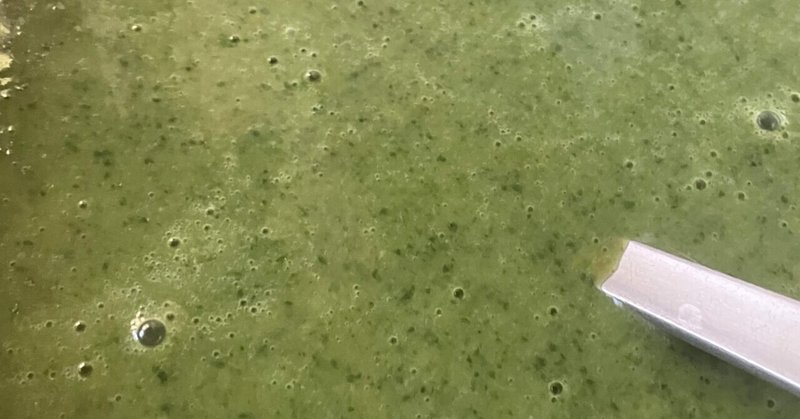
出不精な春のポタージュ potage lié de printemps for feeling lazy
貧乏人の歳時記
A minimalist's seasonal calendar
ストーリー
Recipe trivia
冬から春にかけて、だらだら収穫できるのが嬉しくて、スティックセニョール(日本で品種改良された脇芽を収穫するタイプのブロッコリー)や芽キャベツ、サンチュをプランターに植えている。最初の頃は薹が立ち始めると処分して、土を漉き直して夏野菜の苗を植えていたのだけど、途中から面倒になって放置したら、元々二年草か多年草のようで、次の年にもまた収穫できるようになった。ふと見ると芽キャベツの葉はとても柔らかく、普通にキャベツとして食べられることに気がついた。ブロッコリーの葉も少し硬いけどケールと同じ使い方ができる(キャベツの原種はケールと言われてる)。だから春はほぼ青物を買いにでる必要がなく、リモートワークの引きこもりサイクルの時は嬉しい。プランターを見て回ると毎日ボールいっぱい収穫できるので、冷蔵庫に残った根菜と一緒にポタージュにしてしまう。
この日は、冷蔵庫に人参のヘタと尻尾、南瓜があったので、雑草化しているイタリアンパセリとツルナ、本当に雑草のハコベもたっぷり放り込んで、ポタージュ仕立てにする。季節外れの南瓜がある理由は、南瓜や冬瓜など瓜の仲間は夏の終わりに収穫して、皮に傷さえつけなければ、常温で春まで保管できるからだ。シーズンの終わりに安くなったのを見越して沢山買ってキッチンの涼しいところにころがしておくと良い。去年の分は、スープとお菓子に使ってこれで終了。半年腐らずに保存できたことになる。
サンチュをサラダとパートナーのお弁当のロールサンドにして、葉野菜がいっぱいの朝の時間が完結する。野菜だけで十分すぎるほど美味しいので、意図せずベジタリアンメニューということになった。
I'm happy to be able to harvest from winter to spring, so I plant stick senor (a type of broccoli bred in Japan that harvests side shoots), Brussels sprouts, and non-heading lettuce in a planter. At first, I would get rid of them when they started to shoot, re-filter the soil, and plant summer vegetable seedlings, but halfway through I got tired of it and left them alone, and it seems that they were originally biennial or perennial plants, so I could harvest them again the next year. I suddenly realized that Brussels sprout leaves are very soft and can be eaten as normal cabbage. Broccoli leaves are a little hard, but they can be used in the same way as kale (it is said that the original species of cabbage is kale). So in spring, I hardly have to go out to buy greens, which is nice when I'm in a cycle of staying at home and working remotely. I can harvest a bowl full every day by looking around the planter, so I make a potage with the root vegetables left in the refrigerator.
On this day, I had carrot stems and tails and a pumpkin in the fridge, so I threw in some Italian parsley and vine, which have turned into weeds, and chickweed, which is actually a weed, and made a potage. The reason there was pumpkin out of season is that squash, winter melon, and other melon-like vegetables are harvested at the end of summer, and as long as the skin is not damaged, they can be stored at room temperature until spring. It's a good idea to buy a lot at the end of the season when they become cheaper and keep them in a cool place in the kitchen. I used last year's stock in soups and sweets, and that's it. It means it has been preserved for half a year without spoiling.
I made lettuce into a salad and a roll sandwich for my partner's lunch box, completing a morning full of leafy vegetables. The vegetables were more than enough and delicious, so it ended up being a vegetarian menu unintentionally.
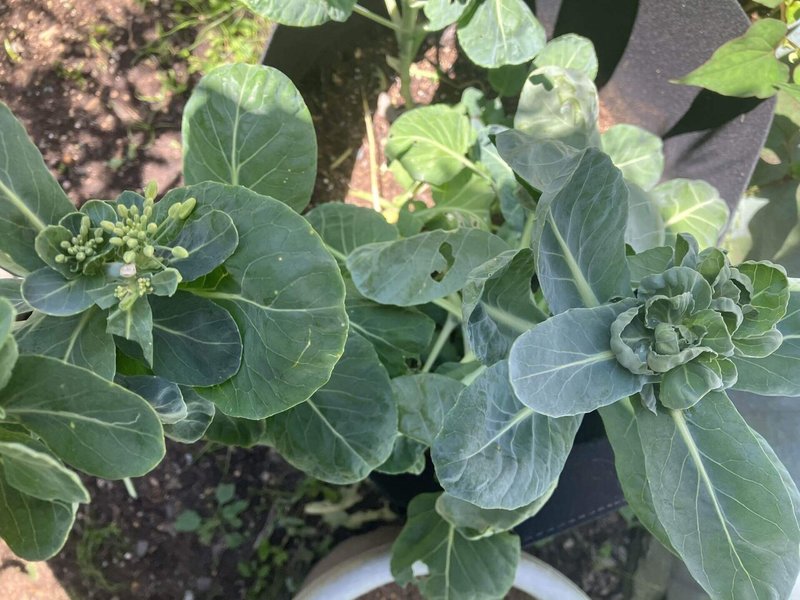
Ingredients:
材料:
芽キャベツの葉※
スティックセニョールの葉※
イタリアンパセリ※
ツルナ※
ハコベ※
人参
南瓜
玉葱
エノキ茸
豆乳
自然塩
胡椒
※要は、なんでも良い。手に入った葉野菜や野草。
Brussels sprout leaves*
Stick senor leaves*
Italian parsley*
Okinawa spinach*
Chickweed*
Carrots
Pampkin
Onion
Enoki mushrooms
Soy milk
Natural salt
Pepper
*The point is, anything will do. Any leafy vegetables or wild plants you can get your hands on.
procedure:
手順:
玉葱はスライスしておく。南瓜と人参は小さく切り分けておく。エノキ茸は石突をとって二等分しておく。
収穫した葉物は良く洗って、大まかに切り分けておく。
野菜を全て鍋に入れ、水を注いで加熱し、沸騰したら弱火にして、野菜が柔らかくなるまで煮込む。
ハンドミキサーなどで粉砕し、とろみのついたポタージュにする。
塩胡椒で味付けをし、好みの量の豆乳を注いで火を止め、提供する。豆乳は煮すぎると分離するので、提供直前に入れると良い。
Slice the onion. Cut the pumpkin and carrot into small pieces. Remove the base of the enoki mushrooms and cut them in half.
Wash the harvested leafy vegetables thoroughly and cut them roughly into pieces.
Put all the vegetables in a pot, add water and heat. Once boiling, reduce heat to low and simmer until the vegetables are soft.
Crush the vegetables using a hand mixer to make a thick potage.
Season with salt and pepper, pour in the desired amount of soy milk, turn off the heat, and serve. If the soy milk is cooked for too long it will separate, so it's best to add it just before serving.

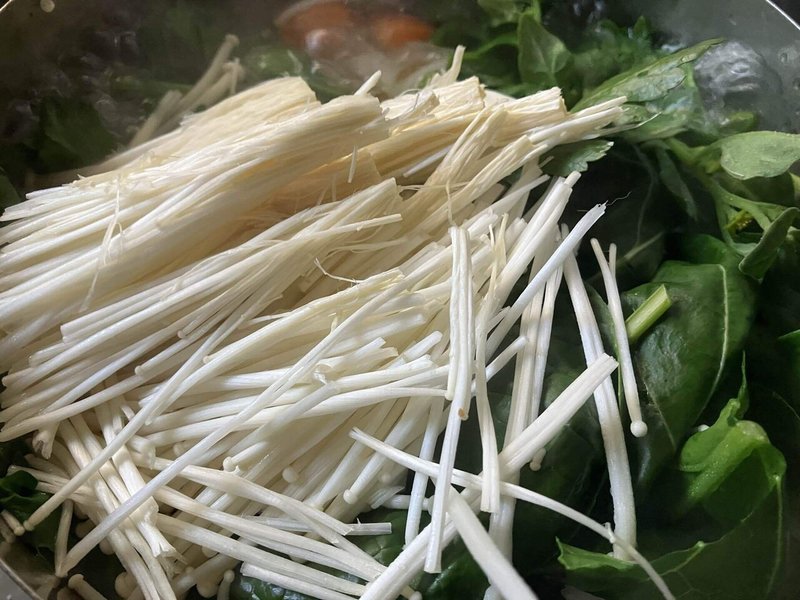
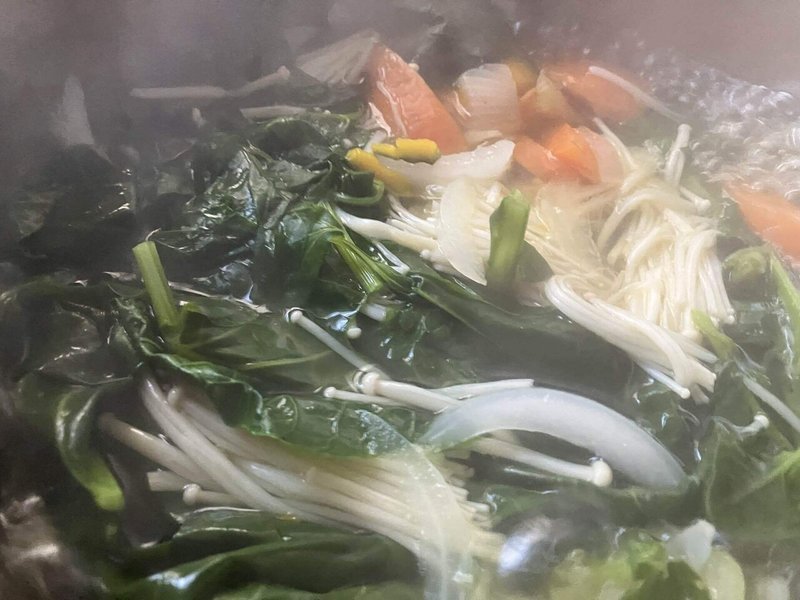
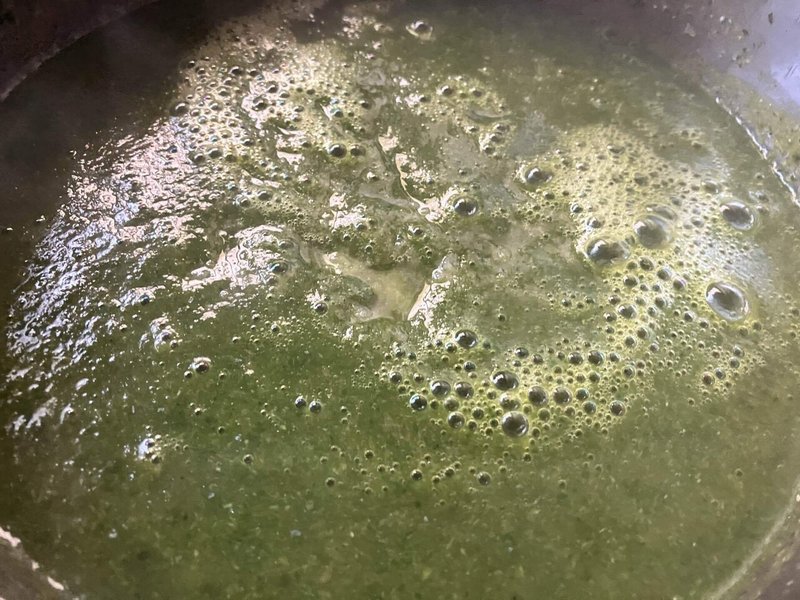
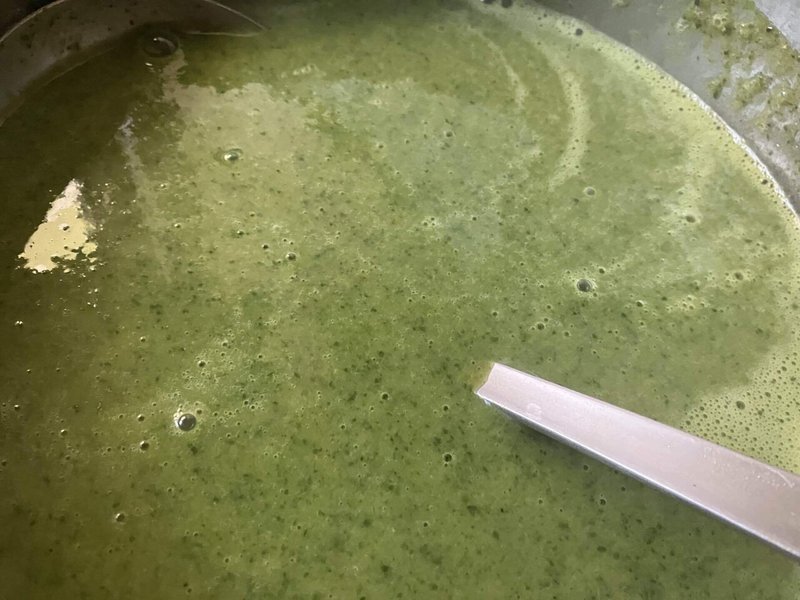
Tips and tricks:
コツと応用のヒント:
材料全体の甘味が少ないので、玉葱を入れている。また、旨みを補うためにエノキ茸を入れた。玉葱は長ネギの白い茎やリーキでも良いし、きのこの種類ははなんでも良い。
このスープは野菜の構成バランスでかなり味が変わる。玉葱と根菜、葉野菜、きのこのバランスをうまく取ると、素晴らしい調和が生まれ、出汁など入れる必要がなくなる。ベジタリアンでなくとも、動物性の素材追加の必要を感じなくなる。
バランスをとる目安は中国の薬膳など東洋伝統の食養生の教えに倣うと簡単で、例えば「五味五色」という教えを使う。五という数字は陰陽五行の世界観に基づいた基準なので、そう難しく考える必要はない。要は五種くらいのものを組み合わせるという現代的解釈をすれば良い。五味は甘い野菜(玉葱、人参、南瓜)、辛い野菜(アブラナ科の野菜)、苦い野菜(パセリ、レタス)、酸味のある野菜(レモンや発酵した野菜)、旨みのある野菜(きのこや海藻)のように、多少こじつけでも良いので、分類してみてバランスが取れているか考える習慣を身につけると良い。五色も同様だ。赤い野菜、黄色い野菜、青(緑)い野菜、茶色い野菜、黒い野菜といった具合だ。これは実は結構合理的な考え方と言える。野菜を構成する化学物質が、その野菜の典型的な味や色を作り出す。だからバランスの良い栄養を取り込むために発達した人間の視覚や味覚がその組み合わせに充足感を感じる。そういう風に解釈すると、とても分かりやすい。
手に入る野菜は季節によって違うけど、こういう風にバランスをとる習慣をつけておけば、季節ごとの野菜の特徴を掴んで、バランスの良い滋味に富んだ飽きのこないスープを作れるようになる。
このスープには油分は含まれていないけど、油を補う必要があるならば、野菜をオリーブオイルなどの油で炒めてから煮るとよい。
香りのアクセントが欲しい場合は、クミンやコリアンダーなどのスパイスを足しても良い。
Since the ingredients overall are not very sweet, I added onions. I also added enoki mushrooms to add more umami. You can use the white stems of green onions or leeks instead of onions, and any type of mushroom will do.
The taste of this soup changes significantly depending on the balance of the vegetables. If you get the balance of onions, root vegetables, leafy vegetables, and mushrooms right, it will create a wonderful harmony and you won't need to add stock. Even if you're not vegetarian, you won't feel the need to add animal ingredients.
The easiest way to achieve balance is to follow the teachings of traditional Eastern dietary therapy, such as Chinese medicinal cuisine, and use the teachings of "five tastes and five colors." The number five is a standard based on the worldview of Yin-Yang and the Five Elements, so there's no need to think too hard about it. Basically, you can interpret it in a modern way as combining about five types of ingredients. The five tastes are sweet vegetables (onions, carrots, squash), spicy vegetables (cruciferous vegetables), bitter vegetables (parsley, lettuce), sour vegetables (lemon and fermented vegetables), and savory vegetables (mushrooms and seaweed). It's fine to classify them a little, but it's good to get into the habit of thinking about whether they are balanced. The same goes for the five colors. Red vegetables, yellow vegetables, blue (green) vegetables, brown vegetables, black vegetables, and so on. This is actually a pretty rational way of thinking. The chemicals that make up a vegetable create the typical taste and color of that vegetable. That's why human eyes and taste, which have developed to take in balanced nutrients, feel satisfied with that combination. If you interpret it like that, it's very easy to understand.
The vegetables you can get will vary depending on the season, but if you get into the habit of balancing them in this way, you'll be able to grasp the characteristics of seasonal vegetables and make a well-balanced, nutritious soup that you won't get tired of.
This soup doesn't contain any oil, but if you need to add oil, you can fry the vegetables in olive oil or other oil before boiling them.
If you want to add a more aromatic kick, you can add spices such as cumin or coriander.
Guide to where to get ingredients and equipment 材料と機材の入手先ガイド
この記事が気に入ったらサポートをしてみませんか?

